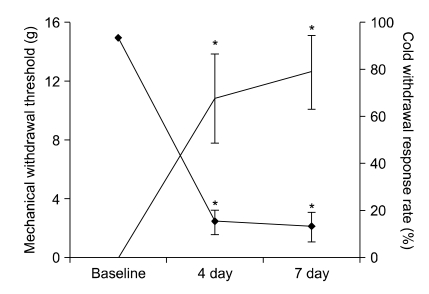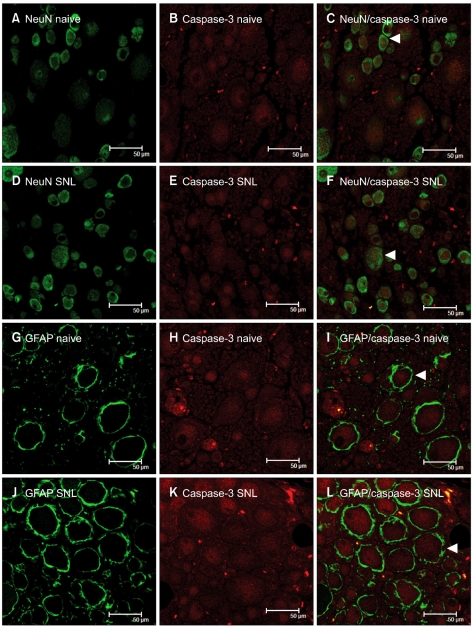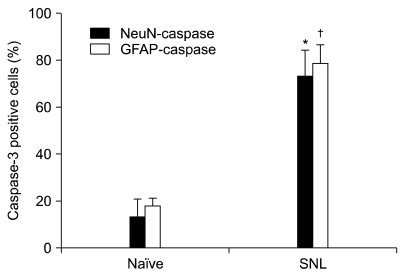Tumor Necrosis Factor-alpha and Apoptosis Following Spinal Nerve Ligation Injury in Rats
- Affiliations
-
- 1Department of Anesthesiology and Pain Medicine, Asan Medical Center, University of Ulsan College of Medicine, Seoul, Korea. jgleem@amc.seoul.kr
- KMID: 2074012
- DOI: http://doi.org/10.3344/kjp.2011.24.4.185
Abstract
- BACKGROUND
Spinal nerve ligation (SNL) injury in rats produces a pain syndrome that includes mechanical and thermal allodynia. Previous studies have indicated that proinflammatory cytokines such as tumor necrosis factor-alpha (TNF-alpha) play an important role in peripheral mediation of neuropathic pain, and that altered dorsal root ganglion (DRG) function and degree of DRG neuronal apoptosis are associated with spinal nerve injury. The present study was conducted to evaluate the expression of TNF-alpha and the extent of apoptosis in the dorsal root ganglion after SNL in rats.
METHODS
Sprague-Dawley rats were subjected to SNL of the left L5 and L6 spinal nerves distal to the DRG and proximal to the formation of the sciatic nerve. At postoperative day 8, TNF-alpha protein levels in the L5-6 DRG were compared between SNL and naive groups using ELISA. In addition, we compared the percentage of neurons injured in the DRG using immunostaining for apoptosis and localization of activated caspase-3.
RESULTS
SNL injury produced significant mechanical and cold allodynia throughout the 7-day experimental period. TNF-alpha protein levels were increased in the DRG in rats that had undergone SNL (12.7 +/- 3.2 pg/100 microg, P < 0.001) when compared with naive rats (4.1 +/- 1.4 pg/100 microg). The percentage of neurons or satellite cells co-localized with activated caspase-3 were also significantly higher in rats with SNL than in naive rats (P < 0.001, P < 0.05, respectively).
CONCLUSIONS
SNL injury produces mechanical and cold allodynia, as well as TNF-alpha elevation and apoptosis in the DRG.
MeSH Terms
Figure
Cited by 5 articles
-
Effects of Ethyl Pyruvate on Allodynia, TNF-α Expression, and Apoptosis in the Dorsal Root Ganglion after Spinal Nerve Ligation Injury
Dae Kee Choi, Jeong Gill Leem, Jin Woo Shin, Jeong Hun Suh
Korean J Pain. 2012;25(4):213-220. doi: 10.3344/kjp.2012.25.4.213.Effect of Ethyl Pyruvate on Paclitaxel-Induced Neuropathic Pain in Rats
Seong Soo Choi, Won Uk Koh, Jae Sik Nam, Jin Woo Shin, Jeong Gill Leem, Jeong Hun Suh
Korean J Pain. 2013;26(2):135-141. doi: 10.3344/kjp.2013.26.2.135.Effects of Nefopam on Streptozotocin-Induced Diabetic Neuropathic Pain in Rats
Jae Sik Nam, Yu Seon Cheong, Myong Hwan Karm, Ho Soo Ahn, Ji Hoon Sim, Jin Sun Kim, Seong Soo Choi, Jeong Gil Leem
Korean J Pain. 2014;27(4):326-333. doi: 10.3344/kjp.2014.27.4.326.Synergistic interaction between acetaminophen and L-carnosine improved neuropathic pain via NF-κB pathway and antioxidant properties in chronic constriction injury model
Bamidele Victor Owoyele, Ahmed Olalekan Bakare, Olutayo Folajimi Olaseinde, Mohammed Jelil Ochu, Akorede Munirdeen Yusuff, Favour Ekebafe, Oluwadamilare Lanre Fogabi, Treister Roi
Korean J Pain. 2022;35(3):271-279. doi: 10.3344/kjp.2022.35.3.271.Involvement of the spinal γ-aminobutyric acid receptor in the analgesic effects of intrathecally injected hypertonic saline in spinal nerve-ligated rats
Myong-Hwan Karm, Hyun-Jung Kwon, Euiyong Shin, Honggyoon Bae, Young Ki Kim, Seong-Soo Choi
Korean J Pain. 2023;36(4):441-449. doi: 10.3344/kjp.23162.
Reference
-
1. George A, Schmidt C, Weishaupt A, Toyka KV, Sommer C. Serial determination of tumor necrosis factor-alpha content in rat sciatic nerve after chronic constriction injury. Exp Neurol. 1999; 160:124–132. PMID: 10630197.
Article2. George A, Buehl A, Sommer C. Wallerian degeneration after crush injury of rat sciatic nerve increases endo- and epineurial tumor necrosis factor-alpha protein. Neurosci Lett. 2004; 372:215–219. PMID: 15542243.
Article3. Schäfers M, Geis C, Svensson CI, Luo ZD, Sommer C. Selective increase of tumour necrosis factor-alpha in injured and spared myelinated primary afferents after chronic constrictive injury of rat sciatic nerve. Eur J Neurosci. 2003; 17:791–804. PMID: 12603269.
Article4. Shubayev VI, Myers RR. Axonal transport of TNF-alpha in painful neuropathy: distribution of ligand tracer and TNF receptors. J Neuroimmunol. 2001; 114:48–56. PMID: 11240015.
Article5. Micheau O, Tschopp J. Induction of TNF receptor I-mediated apoptosis via two sequential signaling complexes. Cell. 2003; 114:181–190. PMID: 12887920.
Article6. Sekiguchi M, Kobayashi H, Sekiguchi Y, Konno S, Kikuchi S. Sympathectomy reduces mechanical allodynia, tumor necrosis factor-alpha expression, and dorsal root ganglion apoptosis following nerve root crush injury. Spine (Phila Pa 1976). 2008; 33:1163–1169. PMID: 18469688.
Article7. Sekiguchi M, Sekiguchi Y, Konno S, Kobayashi H, Homma Y, Kikuchi S. Comparison of neuropathic pain and neuronal apoptosis following nerve root or spinal nerve compression. Eur Spine J. 2009; 18:1978–1985. PMID: 19543754.
Article8. Joseph EK, Levine JD. Caspase signalling in neuropathic and inflammatory pain in the rat. Eur J Neurosci. 2004; 20:2896–2902. PMID: 15579143.
Article9. Li Y, Dorsi MJ, Meyer RA, Belzberg AJ. Mechanical hyperalgesia after an L5 spinal nerve lesion in the rat is not dependent on input from injured nerve fibers. Pain. 2000; 85:493–502. PMID: 10781924.
Article10. Han DW, Kweon TD, Kim YA, Choi JB, Lee YW. The expression of the Ca++ channel alpha2delta subunit and TRPM8 in the dorsal root ganglion of sympathetically maintained pain and sympathetic independent pain rat models. Korean J Pain. 2008; 21:11–17.
Article11. Woolf CJ, Salter MW. Neuronal plasticity: increasing the gain in pain. Science. 2000; 288:1765–1769. PMID: 10846153.
Article12. Wagner R, Myers RR. Schwann cells produce tumor necrosis factor alpha: expression in injured and non-injured nerves. Neuroscience. 1996; 73:625–629. PMID: 8809782.
Article13. Woolf CJ, Allchorne A, Safieh-Garabedian B, Poole S. Cytokines, nerve growth factor and inflammatory hyperalgesia: the contribution of tumour necrosis factor alpha. Br J Pharmacol. 1997; 121:417–424. PMID: 9179382.
Article14. Sorkin LS, Doom CM. Epineurial application of TNF elicits an acute mechanical hyperalgesia in the awake rat. J Peripher Nerv Syst. 2000; 5:96–100. PMID: 10905468.
Article15. Schäfers M, Geis C, Brors D, Yaksh TL, Sommer C. Anterograde transport of tumor necrosis factor-alpha in the intact and injured rat sciatic nerve. J Neurosci. 2002; 22:536–545. PMID: 11784800.
Article16. Kim KJ, Yoon YW, Chung JM. Comparison of three rodent neuropathic pain models. Exp Brain Res. 1997; 113:200–206. PMID: 9063706.
Article17. Whiteside GT, Munglani R. Cell death in the superficial dorsal horn in a model of neuropathic pain. J Neurosci Res. 2001; 64:168–173. PMID: 11288144.
Article18. Moore KA, Kohno T, Karchewski LA, Scholz J, Baba H, Woolf CJ. Partial peripheral nerve injury promotes a selective loss of GABAergic inhibition in the superficial dorsal horn of the spinal cord. J Neurosci. 2002; 22:6724–6731. PMID: 12151551.
Article19. Maione S, Siniscalco D, Galderisi U, de Novellis V, Uliano R, Di Bernardo G, et al. Apoptotic genes expression in the lumbar dorsal horn in a model neuropathic pain in rat. Neuroreport. 2002; 13:101–106. PMID: 11924868.
Article20. Campana WM, Myers RR. Exogenous erythropoietin protects against dorsal root ganglion apoptosis and pain following peripheral nerve injury. Eur J Neurosci. 2003; 18:1497–1506. PMID: 14511329.
Article21. Jancálek R, Dubový P, Svízenská I, Klusáková I. Bilateral changes of TNF-alpha and IL-10 protein in the lumbar and cervical dorsal root ganglia following a unilateral chronic constriction injury of the sciatic nerve. J Neuroinflammation. 2010; 7:11. PMID: 20146792.
- Full Text Links
- Actions
-
Cited
- CITED
-
- Close
- Share
- Similar articles
-
- Effects of Ethyl Pyruvate on Allodynia, TNF-alpha Expression, and Apoptosis in the Dorsal Root Ganglion after Spinal Nerve Ligation Injury
- Antiallodynic Effect of Thalidomide and Morphine on Rat Spinal Nerve Ligation-induced Neuropathic Pain
- Effects of Tumor Necrosis Factor Alpha Blocker Adalimumab in Experimental Spinal Cord Injury
- Role of Clusterin and Tumor Necrosis Factor Receptors on the Apoptosis of Prostate Cancer Cells
- The Expression and Function of the Tumor Necrosis Factor Receptor I (TNFRI), TNFRII, and X-Linked Inhibitor of Apoptosis Genes after Spinal Cord Injury in Rats




